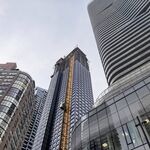In tangential news...
http://www.nytimes.com/2007/08/11/nyregion/11pulaski.html?ref=nyregion
August 11, 2007
After Minneapolis Disaster, Concerns About the Pulaski Skyway
By RUSS BUETTNER
The Pulaski Skyway, a three-mile long steel silhouette rising and falling across the Meadowlands of New Jersey, has over the years attracted its share of praise, curiosity and, for those paying close attention to “The Sopranos,†a glancing kind of television fame.
The bridge, named after Casimir Pulaski, a general in the Continental Army during the American Revolution, was called the “most beautiful†steel bridge by the American Institute of Steel Construction the year it was finished. It was destroyed by Orson Welles’s fictional Martians in his famous “War of the Worlds†radio broadcast in 1938. And more recently, its blackened steel beams flickered past Tony Soprano’s face in the opening sequence of the hit HBO show.
In the last week, though, the 75-year-old bridge has gained another kind of notoriety: It is one of 756 bridges across the country built in the same antiquated design as the bridge that collapsed in Minneapolis. These bridges, engineers now say, possess a distinctive lack of secondary support, meaning that the failure of just one piece of steel could send them plummeting to the ground.
And the Pulaski Skyway, again like the Minnesota bridge, has been found in recent years to be “structurally deficient,†a term indicating concern about several key aspects of its durability, but not a risk of imminent collapse.
Gov. Jon S. Corzine of New Jersey insisted this week that all the state’s bridges were safe, but suggested that the skyway might be at a critical juncture.
Mr. Corzine said that instead of spending the $10 million a year now planned to keep the skyway safe and operational, it might be wiser to replace it. But it is not clear where the $1 billion needed to do so would come from.
The exact nature of the government’s concern about the skyway has not been made public. This spring, inspectors finished the complete inspection of the bridge that the federal government requires every two years.
But the State Department of Transportation, citing security concerns, refused to release the records of that inspection or discuss whether the findings differed substantially from those of the previous inspection. Another inspection, in response to the Minneapolis collapse, is under way.
The skyway passed its previous inspection, in 2004, though problems were noted, according to federal data.
The federal government’s rating system scores bridges on a scale of 0 to 9 in several categories, with 9 being perfect and 0 requiring a shutdown. In 2004 the skyway was rated 4 for the physical condition of its structural members and 5 for the physical condition of its piers and other substructure components.
Those numbers are not dire. But the scores are similar to those assigned to the bridge in Minneapolis. It received a 4 for structure and 6 for substructure during its most recent inspection.
For all its similarities to the Minneapolis bridge, which was completed in 1967, the Pulaski Skyway, though 35 years older, may have some advantages.
For example, the skyway may be much more sturdy than the bridge in Minneapolis, said John Schuring, a professor in the department of civil engineering at the New Jersey Institute of Technology. Because less was known then about how much weight various materials could handle, engineers of the era generally added more steel support than was later considered necessary.
“A lot of the bridges built back in the first half of the 20th century are a lot more robust,†he said.
The utility of the skyway has rarely been in doubt. Originally called the Newark-Jersey City viaduct, it was built to move the thousands of cars and trucks a day that began to emerge from the Holland Tunnel after it was completed in 1927.
Its fast passage across the Passaic and Hackensack Rivers provided the final link between Manhattan and the nation’s first “superhighway,†the transcontinental Lincoln Highway. On its first day of operation in 1932, 48,611 cars crossed the skyway; today the number averages 85,000, according to the Department of Transportation.
“The thing that the Pulaski Skyway does is that it allows you to leap over all the railyards, the Meadowlands, the industrial wastelands that pepper that area,†said Jeffrey M. Zupan, a senior fellow for transportation at the Regional Plan Association. “It’s an extraordinary thing.â€
As swift as that eight-minute-or-so journey can be, it is also often an unsettling experience. The skyway was modeled after railroad bridges, with lanes that were uncomfortably narrow and, originally, undivided.
Those factors proved deadly to car passengers. In the skyway’s first 14 months of operation, 14 people in cars were killed in crashes with trucks on the bridge. Jersey City banned trucks from the bridge in early 1934.
“When they banned truck traffic there, they made the skyway 90 percent obsolete of its intended purpose,†said Steven Hart, author of “The Last Three Miles: Politics, Murder, and the Construction of America’s First Superhighway,†a recently published history of the skyway.
But removing trucks may have lengthened the skyway’s lifespan, saving it from years of added weight and vibrations, which engineers at the time did not know caused steel to fatigue and eventually crack, Mr. Schuring said.
The distinctive design in question is known as “steel truss deck,†in which the roadway sits atop interconnected triangles of steel girders. The Pulaski Skyway, composed of steel truss decks and two cantilevered sections over the rivers, is the eighth-most heavily traveled such bridge in the nation, and the busiest in the metropolitan region, according to federal bridge data.
All bridges of that design are being reinspected in the wake of the Minneapolis collapse. There are eight in New Jersey, 33 in New York and six in Connecticut.
The skyway last underwent major repairs in the mid-1980s, when its roadway was resurfaced and steel supports were reinforced at a cost of about $19 million.
A new round of repairs is set to begin this month. They include replacing the pier caps, the points where the steel structure connects and transfers weight to the massive concrete pillars below, key points of stress. The safety wall along the side of the lanes will also be repaired, and the concrete that encases the steel under the roadway deck will be removed and replaced in sections.
“These are our best efforts to rehabilitate the Pulaski Skyway to a fully functional state,†said Sandra Gutarra, a spokeswoman for the State Department of Transportation.
The repairs, combined with the lucky turning points in the skyway’s past, have led experts to refrain from raising alarm.
“I would not panic about the Pulaski,†Mr. Schuring said. â€We have to continue to watch it closely, but I would not just say that we have to quickly replace it.â€





